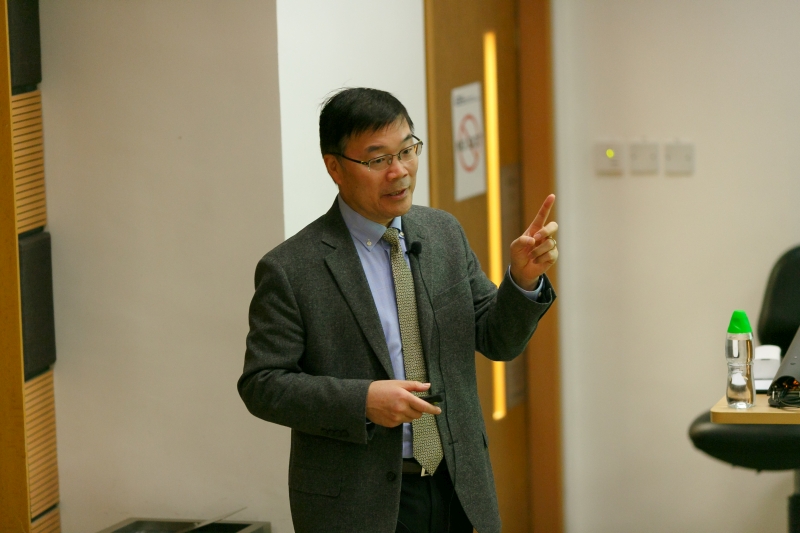In-situ Microscopy with Atomic Resolution at Atmospheric Pressure
Abstract
Understanding the atomic structures of catalysts under realistic conditions with atomic precision is crucial to design better materials for challenging transformations. For example, under reducing conditions, certain reducible supports migrate onto supported metallic particles and create strong metal−support states that drastically change the reactivity of the systems. The details of this process are still unclear and preclude its thorough exploitation. In the past decade, most of atomic-scale transmission electron microscopy (TEM) studies involving gas-solid interactions were conducted in an environmental TEM, where the gas pressure is typically limited to less than 1/100 of atmosphere. Recently, it has become possible to overcome this limitation through a MEMS-based, electron-transparent closed cell with a heating stage.
In this lecture, the speaker will present his recent results using this device (the Protochips AtmosphereTM system) in selected catalyst systems. In a palladium/titania (Pd / TiO2) catalyst, he directly observed the formation of the oxide overlayers on the supported Pd particles with atomic resolution under atmospheric pressure and high temperature. It shows that an amorphous reduced titania layer is formed at low temperatures, and that crystallization of the layer into either mono- or bilayer structures is dictated by the reaction environment. This transition occurs in combination with a dramatic reshaping of the metallic surface facets. In-situ TEM observations of a modular Pd-ceria core-shell nanostructured catalyst (Pd@CeO2) showed that an unexpected structural transformation occurs upon heating at high temperatures. The system reaches a stable state with the mixture of nanoparticles with two different sizes, which accounts for the exceptional catalytic properties that have been reported. Using the similar techniques, he also studied the core-shell platinum-metal (Pt-M) nanoparticles which show a catalytic performance in the oxygen reduction reaction (ORR) superior to that of pure Pt nanoparticles. To understand the formation mechanism of the Pt shell, he studied thermally activated core-shell formation in Pt3Co nanoparticles via in-situ electron microscopy with the gas cell. The disordered Pt3Co nanoparticle was found to transform into an ordered intermetallic structure after annealing at high temperature (725 °C) in 760 Torr O2, followed by layer-by-layer Pt shell growth on (100) surfaces at low temperature (300 °C). The apparent ‘anti-oxidation’ phenomenon promoted by the ordered Pt3Co phase is favorable to the ORR catalyst, which operates in an oxidizing environment.
About the speaker
Prof. Pan Xiaoqing received his PhD in Solid State Physics from Saarland University in 1991. After his postdoctoral research at the Max-Planck Institut für Metallforschung in Stuttgart, he joined the faculty of Department of Materials Science and Engineering at University of Michigan in 1996 and was appointed the Richard F. and Eleanor A. Towner Professor of Engineering and the Director of Electron Microbeam Analysis Laboratory at Michigan. He then moved to University of California at Irvine in 2014 and is currently the Professor and Henry Samueli Endowed Chair in Engineering in Department of Chemical Engineering & Materials Science and Department of Physics and Astronomy. He is also the inaugural Director of the Irvine Materials Research Institute (IMRI).
Prof. Pan's research focuses on understanding the atomic-scale structure-property relationships of advanced functional materials, including oxide electronics, ferroelectrics and multiferroics, and catalysts. He is recognized internationally for his work in electron microscopy that has led to the discovery of new properties and novel functionalities in these technologically important materials.
Prof. Pan received awards including the Faculty Early Career Development (CAREER) Award of US National Science Foundation and the Outstanding Young Investigator Award of the Chinese National Science Foundation. He was an overseas member of the Scientific Review Board of the Chinese Academy of Sciences in 2005 to 2010 and has been serving as a member on the Advisory Committee of the Overseas Chinese Affairs Office of the State Council of China since 2011. He was elected a Fellow of the American Ceramic Society, American Physical Society and Microscopy Society of America. He has also published over 200 peer-reviewed scientific papers in scholarly high impact factor journals including Nature, Science, Nature Materials, Nature Communications, Physical Review Letters, Nano Letters, and Advanced Materials.











